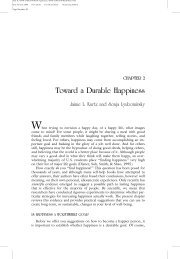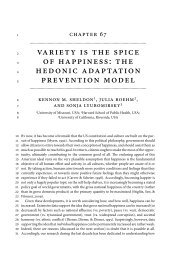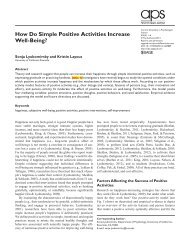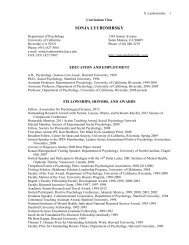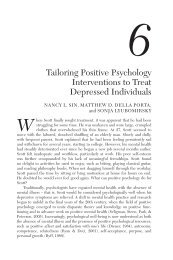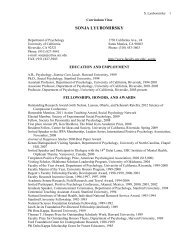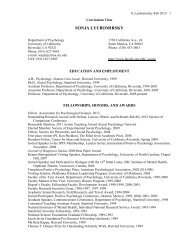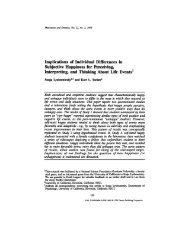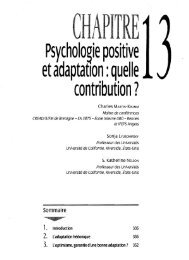Maximizing Versus Satisficing: Happiness Is a Matter of Choice
Maximizing Versus Satisficing: Happiness Is a Matter of Choice
Maximizing Versus Satisficing: Happiness Is a Matter of Choice
Create successful ePaper yourself
Turn your PDF publications into a flip-book with our unique Google optimized e-Paper software.
MAXIMIZING VS. SATISFICING AND WELL-BEING<br />
1179<br />
people cannot have too many options. If, for example, one is trying<br />
to decide between two models <strong>of</strong> a CD player, and then discovers<br />
that a third model also is available, the third model may be just the<br />
thing one is after. If not, one can simply go back to deliberating<br />
between the first two. And one can always ignore the new, third<br />
option altogether. So it seems irrational to perceive oneself as<br />
worse <strong>of</strong>f as a result <strong>of</strong> added possibilities for choice. Nonetheless,<br />
there is now a small body <strong>of</strong> evidence suggesting that added<br />
options are a mixed blessing (e.g., Simenson & Tversky, 1992;<br />
Tversky & Shafir, 1992). Results have begun to appear in the<br />
decision-making literature indicating that adding options can make<br />
a choice situation less rather than more attractive for people—that<br />
indeed, sometimes people prefer it if others make the choices for<br />
them (Beattie, Baron, Hershey, & Spranca, 1994).<br />
In one series <strong>of</strong> studies (Iyengar & Lepper, 2000; see also<br />
Iyengar & Lepper, 1999), participants were more likely to purchase<br />
exotic jams or gourmet chocolates when they had 6 options<br />
from which to choose than when they had 24 or 30, respectively.<br />
And perhaps more importantly, those with fewer options expressed<br />
greater satisfaction with the choices they made. Similarly, university<br />
students were more likely to write an extracredit essay, and<br />
wrote better essays, when they had 6 topics to choose from than<br />
when they had 30. Iyengar and Lepper suggested several possible<br />
factors that may underlie this effect. One is the avoidance <strong>of</strong><br />
potential regret. The more options there are, the more likely one<br />
will make a nonoptimal choice, and this prospect may undermine<br />
whatever pleasure one gets from one’s actual choice. There is<br />
ample evidence that regret aversion is a potent force in decision<br />
making—perhaps even more potent than the loss aversion that has<br />
been a significant feature <strong>of</strong> Kahneman and Tversky’s (1979)<br />
prospect theory <strong>of</strong> decision making (Beattie et al., 1994; Bell,<br />
1982, 1985; Larrick & Boles, 1995; Loomes & Sugden, 1982;<br />
Ritov, 1996; Simenson, 1992; Zeelenberg, 1999; Zeelenberg &<br />
Beattie, 1997; Zeelenberg, Beattie, van der Pligt, & de Vries, 1996;<br />
Zeelenberg et al., 1998).<br />
A second factor that may make increased choice unattractive is<br />
that it creates a seemingly intractable information problem. It is<br />
hard enough to gather information and go through the deliberations<br />
needed to make the best choice among 6 options. To choose the<br />
best among 30 options is truly daunting. So rather than even try,<br />
people may disengage, choosing almost arbitrarily to complete the<br />
process. As a result <strong>of</strong> this disengagement, many <strong>of</strong> the psychological<br />
processes that normally are recruited to enhance the attractiveness<br />
<strong>of</strong> the choices one makes may not be operative (see<br />
Gilovich & Medvec, 1995, for an account <strong>of</strong> some <strong>of</strong> these<br />
processes, in the context <strong>of</strong> their theory <strong>of</strong> regret).<br />
<strong>Maximizing</strong>, <strong>Satisficing</strong>, and <strong>Choice</strong><br />
Schwartz (2000) recently argued that the proliferation <strong>of</strong> options<br />
can have a variety <strong>of</strong> negative effects on well-being. He suggested<br />
that as options are added within a domain <strong>of</strong> choice, three problems<br />
materialize. First, there is the problem <strong>of</strong> gaining adequate<br />
information about the options to make a choice. Second, there is<br />
the problem that as options expand, people’s standards for what is<br />
an acceptable outcome rise. And third, there is the problem that as<br />
options expand, people may come to believe that any unacceptable<br />
result is their fault, because with so many options, they should be<br />
able to find a satisfactory one. Similar problems arise as choice<br />
becomes available in domains in which previously there was no<br />
choice. No matter how dissatisfied one is with one’s telephone<br />
service, if phone service is provided by a regulated monopoly, one<br />
cannot do better, and inadequate service is not one’s fault. However,<br />
when choice <strong>of</strong> phone service becomes available, there is no<br />
longer any reason to tolerate inadequate service, and failure to<br />
obtain adequate service is one’s responsibility. Schwartz (2000)<br />
suggested that people might in general be better <strong>of</strong>f with constrained<br />
and limited choice than with unconstrained choice.<br />
However, expanded opportunities for choice need not have these<br />
negative psychological effects. Consider the different effects that<br />
an expanding array <strong>of</strong> options might have on two people, one <strong>of</strong><br />
whom aims to maximize his or her outcomes in that domain and<br />
one <strong>of</strong> whom aims to satisfice. For the maximizer, added options<br />
pose problems. One cannot be sure that one is making the maximizing<br />
choice without examining all the alternatives. And if it is<br />
impossible or impractical to examine all the alternatives, then<br />
when the maximizer gives up the search and chooses, there will be<br />
a lingering doubt that he or she could have done better by searching<br />
a bit more. Thus, as options proliferate, the likelihood <strong>of</strong><br />
achieving the goal <strong>of</strong> maximization goes down. Further, the potential<br />
for regret is ever present, because the question the maximizer<br />
is asking him- or herself is not “is this a good outcome?” but<br />
“is this the best outcome?”.<br />
Expanded opportunities for choice may have different effects on<br />
the satisficer. The satisficer is looking for something that crosses<br />
the threshold <strong>of</strong> acceptability—something that is good enough.<br />
Adding options in a domain in which the satisficer has already<br />
encountered something good enough need have no effect; the new<br />
options may simply be ignored. With “good enough” rather than<br />
the “best” as a criterion, the satisficer will be less inclined to<br />
experience regret if it turns out that an option better than the<br />
chosen one was available. And if no satisfactory option has been<br />
encountered in a domain, added options will provide new possibilities<br />
for finding something that crosses the “good enough”<br />
threshold. Thus, the risk <strong>of</strong> being made worse <strong>of</strong>f by added options<br />
may be minimal for satisficers.<br />
Are some people maximizers and others satisficers? Do people<br />
differ in the nature <strong>of</strong> the goals they pursue in choice situations?<br />
And if so, do people also differ in their sensitivity to potential<br />
regret? <strong>Is</strong> it concern about potential regret that influences some<br />
people to be maximizers? We addressed these questions in the<br />
present series <strong>of</strong> studies by creating survey instruments designed to<br />
distinguish maximizers from satisficers and to measure sensitivity<br />
to regret. And if people do differ in these respects, does it make a<br />
difference? We addressed this question in the present studies in<br />
several ways. Study 1 examined the relations between one’s scores<br />
on a Maximization Scale and a Regret Scale and scores on measures<br />
<strong>of</strong> happiness, life satisfaction, optimism, depression, neuroticism,<br />
and perfectionism. In subsequent studies we attempted to<br />
validate some <strong>of</strong> these putative relations and to identify possible<br />
mediators. Study 2, guided by the notion that maximizers might<br />
seek more information than satisficers when making decisions,<br />
used a questionnaire to examine relations between maximization<br />
and the amount <strong>of</strong> social comparison that goes into making purchasing<br />
decisions, as well as the satisfaction people derive from<br />
those decisions. Study 3, inspired by findings reported by Lyubomirsky<br />
and Ross (1997) that unhappy people are more affected<br />
by upward social comparison than happy people, further explored



